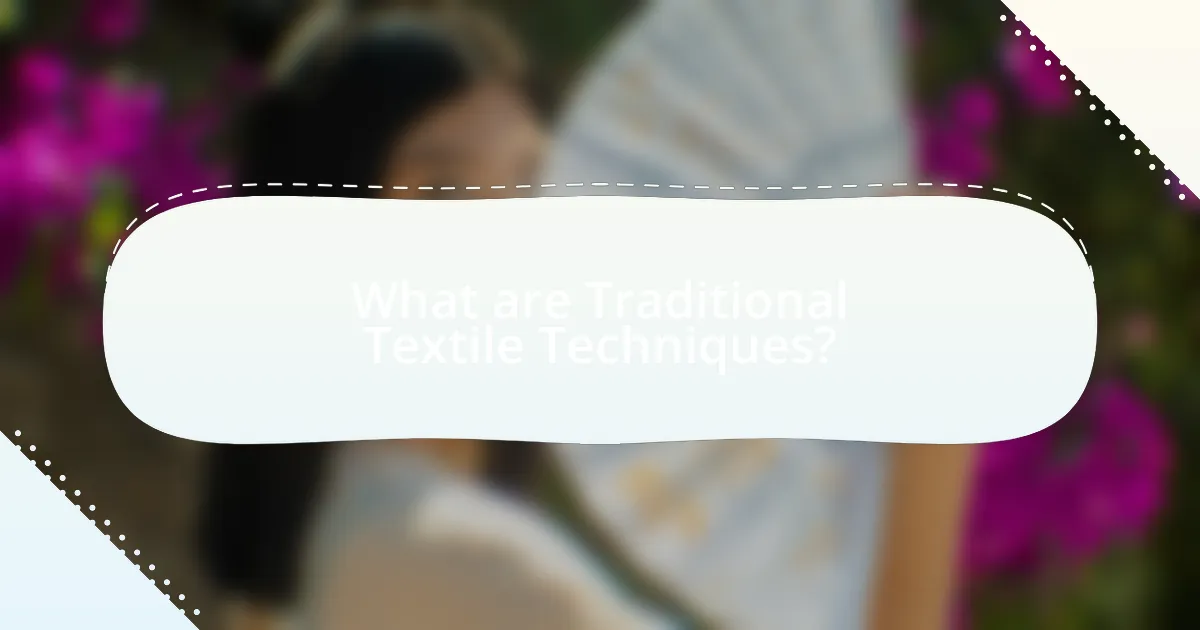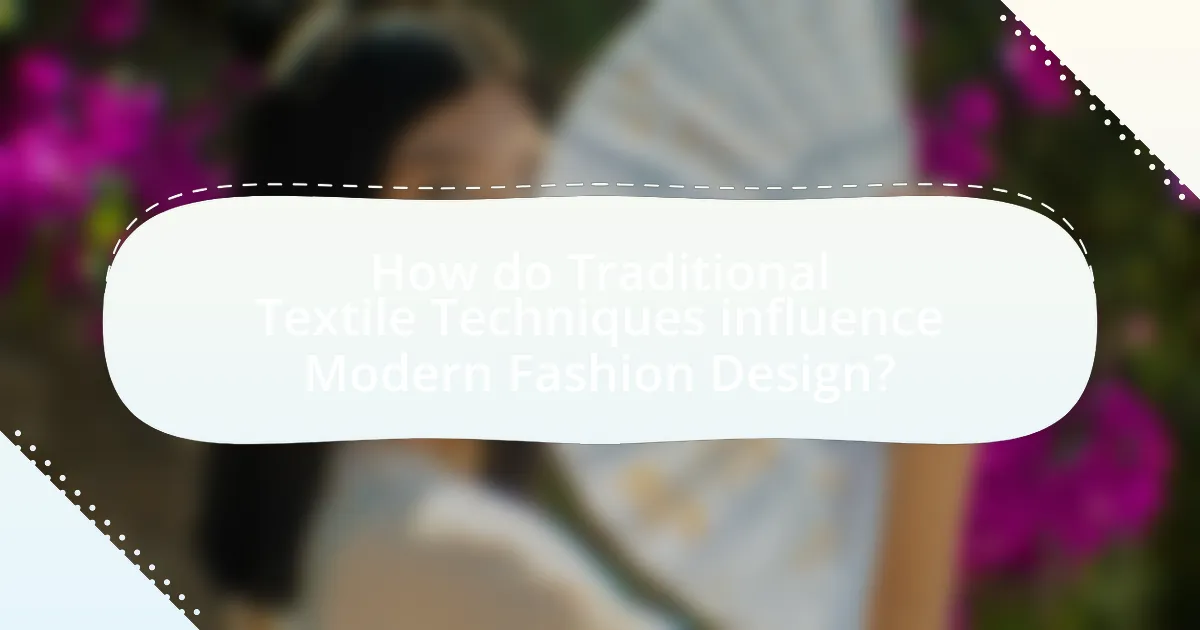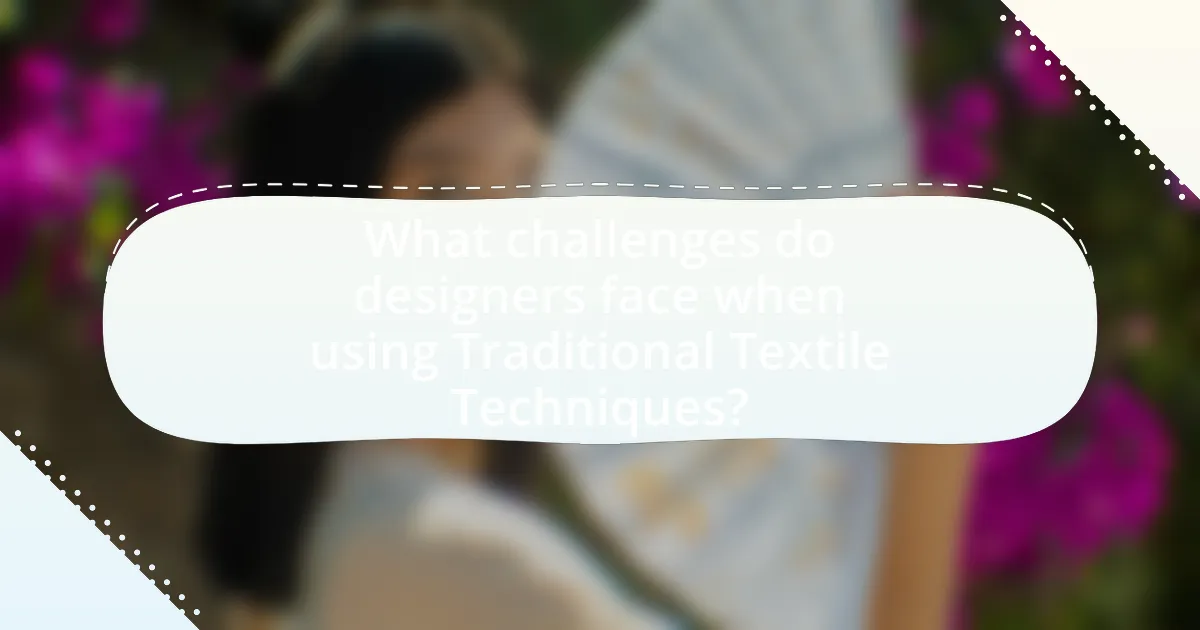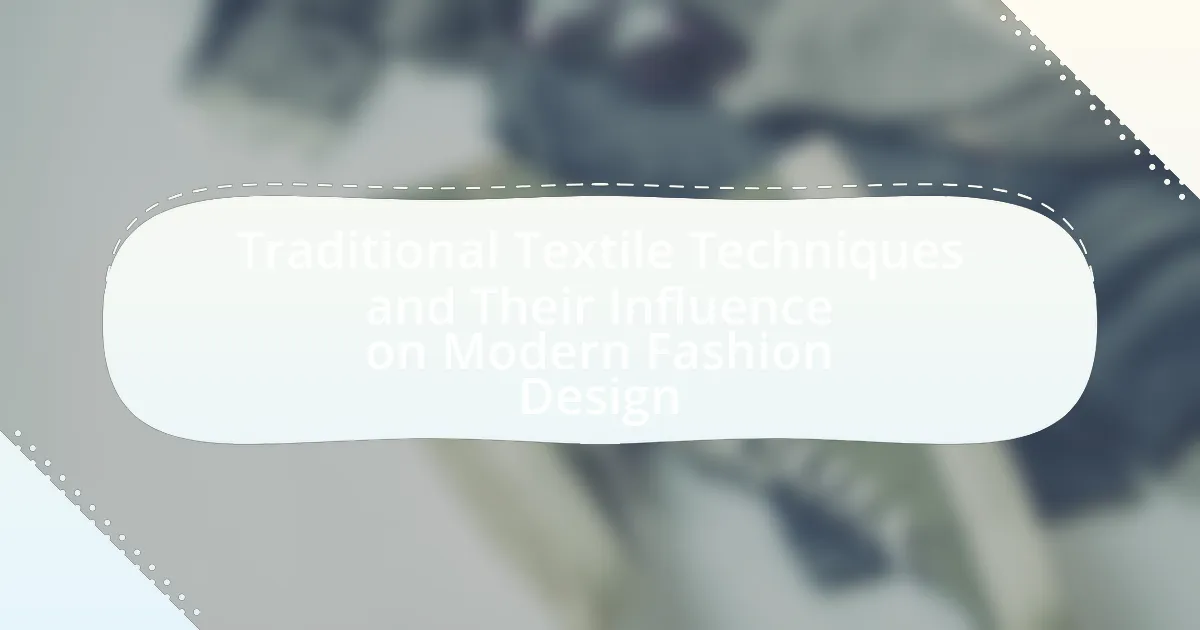Traditional textile techniques encompass methods of fabric production and manipulation that reflect cultural heritage, including weaving, dyeing, embroidery, and printing. These techniques have evolved over time, influenced by historical factors such as cultural exchanges and technological advancements, and are integral to various cultures, notably in Japan, India, Peru, and West Africa. The article explores the significance of these techniques in modern fashion design, highlighting their role in sustainability, cultural identity, and the challenges designers face, such as production costs and cultural appropriation. It emphasizes best practices for integrating traditional methods into contemporary fashion, ensuring authenticity and respect for cultural origins while meeting consumer demand for unique and sustainable garments.

What are Traditional Textile Techniques?
Traditional textile techniques are methods of fabric production and manipulation that have been passed down through generations, often reflecting cultural heritage. These techniques include weaving, dyeing, embroidery, and printing, each with unique processes and materials that contribute to the final textile product. For instance, handloom weaving, a traditional technique, utilizes manual looms to create intricate patterns, while natural dyeing employs plant-based substances to achieve vibrant colors. The historical significance of these techniques is evident in their role in various cultures, such as the use of ikat in Southeast Asia and the intricate embroidery of Persian carpets, which showcase the artistry and craftsmanship inherent in traditional textiles.
How have Traditional Textile Techniques evolved over time?
Traditional textile techniques have evolved significantly over time, transitioning from purely functional methods to complex artistic expressions. Initially, these techniques were developed for practical purposes, such as weaving and dyeing, using natural materials and local resources. Over centuries, advancements in technology and globalization introduced new materials, tools, and influences, leading to the incorporation of synthetic fibers and digital printing methods. For example, the introduction of the Jacquard loom in the early 19th century revolutionized weaving by allowing intricate patterns to be produced more efficiently. Additionally, cultural exchanges through trade routes facilitated the blending of styles and techniques, enriching traditional practices. This evolution reflects a dynamic interplay between heritage and innovation, shaping the textile landscape in contemporary fashion design.
What historical factors influenced the development of these techniques?
The development of traditional textile techniques was influenced by various historical factors, including cultural exchanges, technological advancements, and economic conditions. Cultural exchanges, particularly along trade routes such as the Silk Road, facilitated the sharing of techniques and materials between different civilizations, leading to the evolution of textile arts. Technological advancements, such as the invention of the spinning wheel in the Middle Ages, improved efficiency and quality in textile production. Economic conditions, including the rise of the textile industry during the Industrial Revolution, shifted production methods from artisanal to mechanized processes, further shaping the techniques used in textiles. These factors collectively contributed to the rich tapestry of traditional textile techniques that continue to influence modern fashion design.
Which cultures are most known for their traditional textile techniques?
Cultures most known for their traditional textile techniques include the Japanese, Indian, Peruvian, and West African cultures. The Japanese are renowned for techniques such as indigo dyeing and silk weaving, exemplified by the intricate kimonos and textiles produced in regions like Kyoto. Indian textile traditions, including block printing and embroidery, are celebrated for their vibrant colors and patterns, particularly in states like Rajasthan and Gujarat. Peru is famous for its ancient weaving techniques using alpaca and llama fibers, with the Andean communities preserving these methods for centuries. West African cultures are distinguished by their use of vibrant fabrics like kente cloth and mud cloth, showcasing complex patterns and cultural significance. Each of these cultures has a rich history of textile production that continues to influence modern fashion design.
What are the key types of Traditional Textile Techniques?
The key types of Traditional Textile Techniques include weaving, dyeing, embroidery, and printing. Weaving involves interlacing threads to create fabric, a method that dates back thousands of years and is foundational in textile production. Dyeing is the process of adding color to textiles, with techniques such as natural dyeing using plant materials being historically significant. Embroidery refers to the art of decorating fabric with needle and thread, often used to convey cultural narratives. Printing involves applying designs to fabric surfaces, with block printing being one of the oldest methods. These techniques have shaped the textile industry and continue to influence modern fashion design by integrating traditional aesthetics and craftsmanship into contemporary styles.
What is the significance of weaving in traditional textiles?
Weaving is significant in traditional textiles as it serves as a fundamental technique for creating fabric, reflecting cultural identity and heritage. This craft not only produces functional materials but also embodies artistic expression, often incorporating patterns and motifs that convey historical narratives and social values. For instance, in many indigenous cultures, specific weaving styles are passed down through generations, preserving unique techniques and stories that are integral to their identity. The intricate designs often represent local flora, fauna, or spiritual beliefs, making each piece a cultural artifact. Thus, weaving is not merely a method of fabric production; it is a vital link to cultural continuity and community cohesion.
How does dyeing contribute to the uniqueness of traditional textiles?
Dyeing contributes to the uniqueness of traditional textiles by allowing artisans to create distinct colors and patterns that reflect cultural heritage and local resources. Each dyeing technique, such as indigo dyeing or natural plant-based dyes, imparts specific characteristics to the fabric, making it recognizable and unique to a particular region or community. For instance, the use of indigo in West African textiles not only produces a deep blue hue but also carries historical significance, as it has been used for centuries in various cultural rituals. This combination of color, technique, and cultural context ensures that each piece of dyed textile tells a story, distinguishing it from mass-produced fabrics.
Why are Traditional Textile Techniques important in fashion?
Traditional textile techniques are important in fashion because they preserve cultural heritage and craftsmanship while influencing contemporary design. These techniques, such as weaving, dyeing, and embroidery, often reflect the history and identity of specific communities, providing a narrative that enriches modern fashion. For instance, the use of traditional Japanese indigo dyeing, known as “shibori,” not only showcases unique aesthetic qualities but also connects designers to centuries-old practices. This integration of traditional methods into modern fashion fosters sustainability by promoting slow fashion principles, which prioritize quality and longevity over fast production cycles.
How do these techniques reflect cultural identity?
Traditional textile techniques reflect cultural identity by embodying the historical, social, and artistic values of a community. These techniques, such as weaving, dyeing, and embroidery, often carry specific patterns, colors, and methods that are unique to particular cultures, serving as a visual language that communicates heritage and traditions. For instance, the intricate patterns found in Navajo textiles represent not only aesthetic choices but also spiritual beliefs and stories passed down through generations. This connection between technique and cultural narrative illustrates how traditional practices inform contemporary fashion, allowing designers to incorporate authentic cultural elements into modern designs, thereby preserving and celebrating cultural identity in a globalized context.
What role do traditional textiles play in sustainable fashion?
Traditional textiles play a crucial role in sustainable fashion by promoting eco-friendly practices and preserving cultural heritage. These textiles often utilize natural fibers and traditional dyeing methods, which reduce environmental impact compared to synthetic materials. For instance, studies show that organic cotton and handwoven fabrics consume significantly less water and energy than conventional textiles. Additionally, traditional textile techniques often involve local artisans, supporting fair trade and community economies, which further enhances sustainability in the fashion industry.

How do Traditional Textile Techniques influence Modern Fashion Design?
Traditional textile techniques significantly influence modern fashion design by integrating historical craftsmanship and cultural narratives into contemporary aesthetics. Designers often draw inspiration from traditional methods such as weaving, dyeing, and embroidery, which not only enhance the visual appeal of garments but also imbue them with cultural significance. For instance, the resurgence of handloom fabrics in high fashion reflects a growing appreciation for artisanal skills and sustainable practices, as seen in collections by brands like Stella McCartney and Gucci. This blending of old and new not only preserves cultural heritage but also meets the modern consumer’s demand for authenticity and uniqueness in fashion.
What are the main ways Traditional Textile Techniques are integrated into modern fashion?
Traditional Textile Techniques are integrated into modern fashion primarily through the use of hand-weaving, embroidery, and dyeing methods. Designers often incorporate these techniques to create unique textures and patterns that reflect cultural heritage. For instance, brands like Etro and Missoni utilize traditional weaving methods to produce distinctive fabrics that stand out in contemporary collections. Additionally, the revival of artisanal craftsmanship in fashion has led to collaborations between designers and local artisans, ensuring that traditional skills are preserved while being adapted for modern aesthetics. This integration not only enhances the visual appeal of garments but also promotes sustainability by valuing handmade processes over mass production.
How do designers incorporate traditional patterns and motifs?
Designers incorporate traditional patterns and motifs by integrating them into contemporary designs through various techniques such as digital printing, embroidery, and fabric manipulation. This practice not only preserves cultural heritage but also enhances the aesthetic appeal of modern garments. For instance, designers often study historical textiles to understand the significance and symbolism behind specific patterns, allowing them to reinterpret these elements in a way that resonates with current fashion trends. Additionally, collaborations with artisans skilled in traditional crafts enable designers to maintain authenticity while innovating. This approach is evident in collections that feature indigenous patterns, which have been shown to increase consumer interest and appreciation for cultural diversity in fashion.
What impact do traditional techniques have on fabric selection in modern fashion?
Traditional techniques significantly influence fabric selection in modern fashion by promoting the use of sustainable materials and artisanal craftsmanship. These techniques often emphasize natural fibers and traditional dyeing methods, which align with contemporary trends towards eco-friendly and ethically sourced fabrics. For instance, the resurgence of handwoven textiles and organic cotton reflects a growing consumer preference for authenticity and sustainability, as seen in brands like Eileen Fisher and Stella McCartney, which prioritize these values in their collections. This shift not only enhances the aesthetic appeal of garments but also supports local artisans and preserves cultural heritage, thereby reinforcing the relevance of traditional techniques in today’s fashion landscape.
Why is the revival of Traditional Textile Techniques significant today?
The revival of Traditional Textile Techniques is significant today because it fosters cultural heritage preservation and promotes sustainable practices in the fashion industry. By reviving these techniques, artisans can maintain their cultural identities while providing unique, handcrafted products that stand out in a market dominated by mass production. Furthermore, traditional methods often utilize natural materials and processes, which contribute to environmental sustainability. For instance, a report by the United Nations Conference on Trade and Development highlights that sustainable fashion practices can reduce the industry’s carbon footprint significantly, aligning with global efforts to combat climate change. Thus, the revival of these techniques not only enriches modern fashion but also supports ecological and cultural sustainability.
How does this revival affect consumer choices in fashion?
The revival of traditional textile techniques significantly influences consumer choices in fashion by increasing demand for sustainable and ethically produced garments. As consumers become more aware of the environmental impact of fast fashion, they are increasingly opting for clothing that incorporates these traditional methods, which often emphasize craftsmanship and sustainability. For instance, a report by McKinsey & Company highlights that 66% of global consumers are willing to pay more for sustainable brands, indicating a shift towards valuing quality and ethical production over mass-produced items. This trend not only supports artisans and local economies but also encourages a more thoughtful approach to fashion consumption, leading to a preference for unique, handcrafted pieces that reflect cultural heritage.
What are the environmental benefits of using traditional techniques in modern design?
Using traditional techniques in modern design significantly reduces environmental impact by promoting sustainable practices and minimizing waste. These techniques often rely on natural materials and processes, which decrease reliance on synthetic fibers and chemical treatments that contribute to pollution. For instance, traditional dyeing methods utilize plant-based dyes, which are biodegradable and less harmful to ecosystems compared to synthetic dyes. Additionally, many traditional techniques emphasize craftsmanship and durability, leading to longer-lasting products that reduce the frequency of disposal and the demand for new resources. This approach aligns with the principles of circular economy, where materials are reused and repurposed, further mitigating environmental degradation.

What challenges do designers face when using Traditional Textile Techniques?
Designers face several challenges when using Traditional Textile Techniques, primarily including limited scalability, time constraints, and the need for specialized skills. Limited scalability arises because many traditional techniques are labor-intensive and cannot be easily mass-produced, which restricts designers’ ability to meet high demand. Time constraints are significant as these techniques often require extensive time for processes like hand-weaving or dyeing, making it difficult to align with fast fashion cycles. Additionally, the need for specialized skills presents a challenge, as not all designers possess the expertise required to execute these techniques effectively, which can lead to inconsistencies in quality and design.
How do cultural appropriation issues arise in modern fashion?
Cultural appropriation issues arise in modern fashion when designers adopt elements from marginalized cultures without permission or understanding, often leading to exploitation and misrepresentation. This occurs frequently when fashion brands incorporate traditional textiles, symbols, or styles from indigenous or minority groups, disregarding their cultural significance. For example, the use of Native American headdresses in fashion shows has sparked controversy, as these items hold deep spiritual meaning and are not mere fashion statements. Such actions can perpetuate stereotypes and contribute to the commodification of cultural heritage, highlighting the need for respectful engagement and collaboration with the cultures being represented.
What steps can designers take to respect cultural origins?
Designers can respect cultural origins by conducting thorough research on the cultural significance of traditional textile techniques before incorporating them into their work. This involves understanding the history, symbolism, and context of the textiles, which can prevent cultural appropriation and ensure that designs honor their origins. For example, the use of indigenous patterns should be accompanied by acknowledgment of the communities that created them, as seen in collaborations between designers and indigenous artisans that promote cultural exchange and authenticity. Additionally, designers can engage with cultural representatives to gain insights and feedback, fostering a respectful dialogue that enhances the design process while preserving cultural integrity.
How can designers balance innovation with tradition?
Designers can balance innovation with tradition by integrating traditional textile techniques into contemporary designs while maintaining the essence of both. This approach allows designers to create unique pieces that respect cultural heritage while appealing to modern aesthetics. For instance, the use of handwoven fabrics or traditional dyeing methods can enhance the originality of a collection, as seen in the works of designers like Issey Miyake, who incorporates traditional Japanese techniques into innovative silhouettes. This fusion not only preserves craftsmanship but also attracts consumers seeking authenticity in fashion, as evidenced by a growing market trend towards sustainable and ethically produced garments.
What are the practical considerations for integrating traditional techniques?
Integrating traditional techniques into modern fashion design requires careful consideration of cultural authenticity, material sourcing, and skill preservation. Cultural authenticity ensures that the techniques are represented accurately and respectfully, which can enhance the narrative and value of the fashion piece. Material sourcing involves identifying sustainable and ethically sourced materials that align with traditional practices, as this supports local artisans and communities. Skill preservation is crucial, as it involves training new generations in these techniques to maintain their relevance and continuity. For instance, the revival of hand-weaving techniques in regions like India has not only preserved cultural heritage but also provided economic opportunities for artisans, demonstrating the practical benefits of integrating traditional methods into contemporary design.
How do production costs affect the use of traditional techniques in fashion?
Production costs significantly influence the use of traditional techniques in fashion by determining the feasibility and scalability of these methods. High production costs associated with traditional techniques, such as hand-weaving or artisanal dyeing, often lead brands to favor more cost-effective, mass-production methods. For instance, a study by the Fashion Institute of Technology found that labor-intensive techniques can increase production costs by up to 50%, making them less attractive for large-scale fashion brands focused on profit margins. Consequently, many designers may limit the use of traditional techniques to niche markets or high-end collections, where consumers are willing to pay a premium for craftsmanship and heritage.
What skills are necessary for designers to effectively use these techniques?
Designers need a combination of technical skills, creativity, and cultural knowledge to effectively use traditional textile techniques in modern fashion design. Technical skills include proficiency in sewing, weaving, and dyeing, which are essential for manipulating textiles. Creativity allows designers to innovate and adapt these techniques to contemporary aesthetics. Cultural knowledge is crucial for understanding the historical significance and context of the techniques, ensuring respectful and authentic application. For instance, designers who incorporate traditional Japanese shibori dyeing must understand its cultural roots to avoid appropriation and to honor its heritage.
What are best practices for incorporating Traditional Textile Techniques in modern fashion design?
Best practices for incorporating Traditional Textile Techniques in modern fashion design include collaborating with artisans to ensure authenticity, utilizing sustainable materials that reflect traditional practices, and integrating cultural narratives into contemporary collections. Collaborating with artisans allows designers to learn and preserve techniques such as weaving, dyeing, and embroidery, which can enhance the uniqueness of modern garments. Sustainable materials, like organic cotton or natural dyes, not only honor traditional methods but also align with current eco-conscious trends in fashion. Furthermore, embedding cultural narratives into designs fosters a deeper connection between the garment and its heritage, enriching the storytelling aspect of fashion. These practices not only respect the origins of textile techniques but also appeal to a growing consumer demand for authenticity and sustainability in fashion.

Leave a Reply